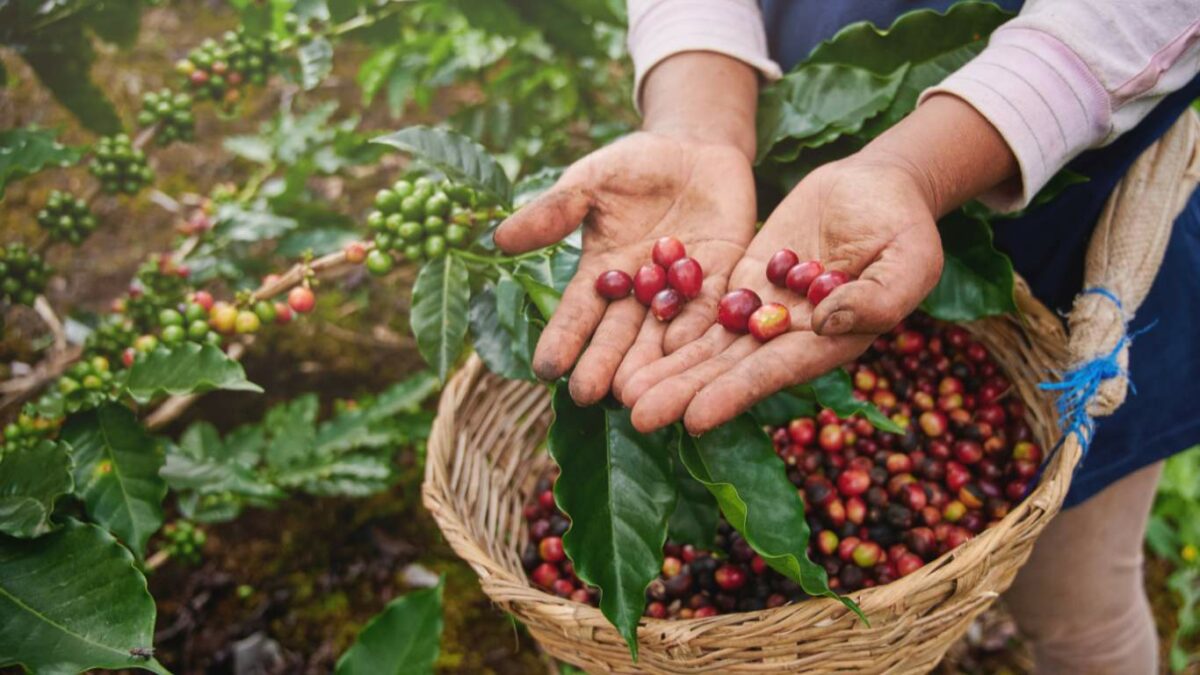Diving into the world of tasting notes is like embarking on a personal flavor adventure. There’s no “right” taste, just what delights your taste buds.
Remember, coffee taste and flavor are highly subjective. It’s all about discovering what you love in a cup of joe and even figuring out the little tweaks to make it just right for you. For coffee pros, especially those in roasting, getting a handle on these flavors isn’t just fun; it’s key to making sure every sip is consistently amazing for everyone.
So, whether you’re a coffee newbie eager to explore or a seasoned expert fine-tuning your craft, understanding coffee’s taste and flavor is your ticket to enjoying fantastic coffee experiences. Let’s get tasting.
Understanding Flavor And How to Judge It
The flavor of coffee can vary dramatically depending on the origin of the beans, the conditions in which they were grown, the method of processing, and the technique of roasting and brewing. That’s not a full list, as even the coffee temperature can affect taste.
This results in a drink that can exhibit a wide range of tastes, from fruity to nutty, floral to spicy, and everything in between.
Let’s talk about some common flavor notes:
Fruity
Many coffees, especially those from regions like Ethiopia or Kenya, can have pronounced fruity flavors. These can range from bright citrus notes to sweet berry undertones or even the more exotic tastes of tropical fruits.
The fruity notes are often a result of the coffee’s acidity, which, when balanced, can make the cup more vibrant and lively.

Nutty
Nutty flavors in coffee are smooth, evoking the taste of almonds and hazelnuts. These flavors are more prevalent in coffees from regions like Brazil or Colombia and are often found in medium-roasted coffees.
You’ll find nuttiness is the most common quality in coffee.
Floral
Floral notes in coffee are delicate and aromatic, reminiscent of jasmine, lavender, or hibiscus. These flavors are typically found in lighter roasts and can be very prominent in coffees from high-altitude regions, such as those in Ethiopia or Guatemala.
Floral notes add a layer of complexity and can make a coffee feel more refined.
Spicy
Spicy flavors add an intriguing twist to coffee, with notes that can range from warm and comforting (think cinnamon or nutmeg) to more piquant (such as black pepper or cloves).
These flavors are often found in coffees from Indonesia or Yemen and can add depth and complexity to the cup.
Using The Coffee Flavor Wheel
The Coffee Flavor Wheel is a great tool for both novices and professionals to expand their understanding of coffee’s taste and aroma. It’s essentially a roadmap to describing coffee, breaking down the complex flavor profile into more manageable and identifiable components.

To use the Flavor Wheel, first start at the middle – these are the most general descriptors. Then, move out one ring at a time until you get more specific. This helps as it’s a lot easier to start with “fruity” than “pomegranate” when describing coffee.
Here are some examples of starting broad, then going more narrow:
- Fruity: Think of the smell of fresh berries, citrus, or dried fruits.
- Floral: Reminiscent of jasmine, lavender, or rose.
- Nutty: Evokes almonds, peanuts, or even the toastiness of browned butter.
- Spicy: Hints of cinnamon, clove, or black pepper that add a warm complexity.
A reminder: there are no wrong answers – describe coffee however you like
Taste Descriptors
Taste is broader than flavor. Where flavor is the descriptor, taste includes attributes like sweetness, or acidity. Coffee is really unique in that it has a huge combination of taste attributes, like the following:
- Sweet: The underlying sweetness that can remind you of sugar cane, honey, or caramel.
- Sour/Acidity: A vibrant, sometimes citrusy brightness that gives coffee its liveliness.
- Bitter: A foundational aspect of coffee’s flavor profile, ranging from mild to intense.
- Salty: Less common but can contribute to the overall flavor balance.
I can’t stress enough how detailed and fun you can get with coffee taste and flavor, although some may say it’s totally confusing! But, I think it’s worth describing the taste attributes separately.
Acidity
Acidity is often misunderstood and sometimes mistaken for an undesirable trait. However, in the world of coffee tasting, acidity is a highly prized characteristic that contributes to the overall brightness, liveliness, and flavor complexity of the coffee.
Acidity in coffee is the pleasant sharpness or tanginess that you can taste primarily on the sides of your tongue. It’s one of the first characteristics noticed when the coffee hits your palate, and it’s responsible for the initial impressions of the taste.
Acidity can be influenced by several factors, including the coffee’s origin, the altitude at which it was grown, processing methods, and roast level. Generally, coffees grown at higher elevations tend to have higher acidity.
Here’s acidity in coffee can be described:
- Citrus: Notes of lemon, lime, or orange, offering a bright and refreshing acidity.
- Berry: Reminiscent of raspberries, blueberries, or blackberries, have a sweetly tart and vibrant acidity.
- Apple: Can range from the tartness of green apples to the sweeter, milder acidity of red apples.
- Stone fruit: Flavors like peach, apricot, or plum provide a juicy and sweet acidity.
- Tropical fruit: Exotic notes such as pineapple, mango, or papaya offer a bold and lively acidity.
Body
Body essentially describes how the coffee feels in your mouth. It’s the sense of heaviness or lightness, the thickness or thinness of the liquid, and how it coats the tongue.
A coffee’s body can significantly affect your overall perception of its quality and flavor, adding another layer to the coffee-tasting experience.
The body of coffee can be categorized into several types. Here are the most common descriptors used:
- Light body: Often described as tea-like or watery, a light-bodied coffee is delicate and doesn’t linger long on the palate. It’s refreshing and easy to drink. It’s best for those who like subtle flavors without a heavy feel.
- Medium body: A step up from light, medium-bodied coffee strikes a balance between being too light or too heavy. It has a more noticeable texture, offering a smooth and pleasant mouthfeel without being overly rich or creamy. It’s often described as silky or velvety.
- Full body: Full-bodied coffees are rich, creamy, and heavy. They have a significant presence in the mouth, coat the tongue, and linger after each sip. These coffees are robust and satisfying, often associated with a luxurious or indulgent experience. The mouthfeel can be compared to whole milk or cream.
- Syrupy: Some coffees, especially those with a very full body, can have a syrupy texture. This descriptor is used for coffees that are exceptionally thick and rich, almost like syrup in consistency, offering a deeply satisfying mouthfeel.
Different brewing methods can also affect the body of coffee. For example, espresso typically has a fuller body due to the concentrated brewing method. Pour-over coffee has a lighter body, highlighting the coffee’s inherent flavors and acidity.

French press coffee has a more pronounced body because the coffee grounds are in direct contact with the water for a longer period, and the oils and fine particles are not filtered out, which results in a heavier mouthfeel.
Aroma
Aroma is the first impression and a precursor to the flavors that unfold after tasting. Aroma deeply influences our perception of taste.
As we drink, the aromas released from the coffee are not just detected through our nostrils but also from the back of our throat, which leads to the retronasal olfactory receptors. This dual pathway allows you to perceive a more comprehensive range of flavors.
The retronasal perception explains why coffee (or any food) tastes bland when we have a cold — with our nasal passage blocked, the aromas cannot reach the retronasal area effectively, diminishing our ability to taste.
Essentially, this connection is crucial because it allows us to perceive flavors more fully. As we sip coffee, the aromas travel to the retronasal area at the back of our nose, which enhances and expands our ability to taste.
The Significance of Aroma in Coffee Tasting
The aroma of coffee is composed of hundreds of volatile compounds that are released during roasting, each contributing to the coffee’s unique scent profile.
Before the coffee even touches your palate, its aroma sets the stage for flavor expectations.
Coffee aromas can be incredibly diverse, reflecting the coffee’s origin, variety, and roasting process.
Here are some common coffee aromas:
- Fruity: Range from citrus fruits like orange and lemon to berries such as strawberries and blueberries, and even tropical fruits like mango and pineapple. Fruity aromas are often associated with lighter roasts and high-altitude coffees.
- Floral: Reminiscent of flowers such as jasmine, lavender, or rose, floral aromas add a delicate and sometimes perfumed quality to coffee.
- Nutty/chocolatey: These comforting aromas can remind you of roasted nuts, cocoa, or even dark chocolate, which results in a rich and satisfying sensory experience. They are more common in medium to dark roasts.
- Spicy: Spices such as cinnamon, clove, or cardamom add complexity and warmth to the overall profile. These are often noted in coffees from regions like Indonesia.
- Earthy/woody: Aromas that evoke fresh earth, wood, or even tobacco are typically found in coffees from Sumatra or other parts of Indonesia. They can add a grounding, robust character to the coffee.
Aftertaste
The aftertaste is the lingering taste sensation that remains in your mouth after you’ve taken a sip of coffee.
The finish can range from sweet and pleasant to bitter or sour, depending on the coffee’s inherent characteristics and how it was brewed. A high-quality coffee typically has a pleasant and lingering finish that complements the initial flavors experienced when the coffee first hits the palate.
These are the characteristics of the finish:
- Duration: Some coffees have a short and clean finish, while others leave a more prolonged taste that slowly fades away.
- Intensity: Some coffees might have a subtle aftertaste, while others can be quite pronounced or even overpowering.
- Flavor: The flavors present in the finish can be a continuation of the initial tasting notes or introduce new flavors that weren’t immediately apparent. Common flavors in the finish include sweetness, bitterness, acidity, and specific notes like chocolate, fruit, or spices.
The aftertaste can also reveal nuances of the coffee’s flavor profile that might not be immediately noticeable and which add depth and complexity to the tasting experience.
What Makes Good Coffee?
What makes a cup of coffee “good” is a question that can elicit as many answers as there are coffee drinkers. However, despite the subjective nature of taste, there are certain universally appreciated characteristics that tend to define the quality of coffee.
Balance, complexity, and a harmonious blend of flavors and sensations are often at the heart of what makes a coffee stand out.

Here is actually what the Specialty Coffee Association (SCA) will include in it’s scoring of different coffees:
Balance
Balance in coffee refers to the harmonious relationship between different taste components—acidity, sweetness, bitterness, and body. A balanced coffee doesn’t allow any single flavor or sensation to overpower the others; instead, they complement each other to create a satisfying whole.
For example, the acidity should lift the coffee’s overall profile without making it sour, and the sweetness should counterbalance any bitterness, with the body providing a satisfying mouthfeel that ties everything together.
Complexity
Complexity in coffee is about the depth and variety of flavors and aromas it presents. A complex coffee will reveal layers of flavors that unfold as you drink it. Complexity can come from the coffee’s origin, the variety of the bean, and how it was processed and roasted.
Distinct Flavor Notes
Good coffee often features several distinct flavor notes that are identifiable and enjoyable. These can range from specific fruit flavors, like berries or citrus, to other natural flavors, like chocolate, nuts, or flowers.
Body and Acidity
A pleasing body and the right level of acidity are also crucial for good coffee. The body should be appropriate to the coffee’s character. It provides a texture that feels right on the palate, whether it’s light and delicate or rich and full.
Acidity, on the other hand, should add brightness and vibrancy without overwhelming the coffee’s other flavors.
Subjectivity in Taste
Finally, it’s important to remember that taste is highly subjective. What one person considers a perfect cup of coffee might not suit another’s preferences. Some might prefer a light, floral, and acidic coffee, while others might enjoy a full-bodied, chocolatey brew with low acidity.
The key is to explore different coffees and find what you personally enjoy. The adventure lies in discovering the unique combinations of flavors, aromas, and sensations that speak to you.




